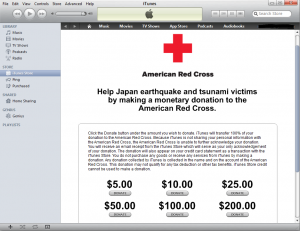Eleven years into the 21st Century, we have seen some of the most horrific natural disasters strike, from the Indian Ocean Tsunami to Hurrican Katrina to other disasters in Haiti, China, Pakistan and the recent incident in Japan. Over the course of these eleven years, warning systems have been implemented, such as the recent earthquake near Japan (however, the warning system gave Japanese residents in the northern region only 15 minutes to move to higher ground). Analyzing these events and the technologies deployed can help other cities prepare, especially in the West Coast where San Francisco, Los Angeles, or Seattle built on fault lines.
Giants
Once a disaster strikes, the goal is to brace for impact, begin search and rescue, and eventually rebuild. The first thing that the international community does is raise money for donation. Others take an extra step to contribute more. In particular, I’m thinking about technology giants such as Google, Microsoft, Twitter and the likes–they contribute skills and resources.
Specifically, the first thing these titans do is bring awareness to the situation, such as having donation links or highlights on their home page. Microsoft set up a page on its Bing search engine, Google inserted a Spotlight on YouTube’s homepage, and many, many more.

One of the most impressive feats is Google working with GeoEye to make satellite-imagery available to Google Earth; these titans have also created a Crisis Response Team to coordinate other logistics. For Japan’s disaster, Google put together an online person-finder data base in several languages for people seeking or providing information for those in need. Microsoft is currently assisting by offering free technical support and temporary software licenses. Apple stores in Japan remained open to let everyone keep in touch with the news on tv or use the Macs to update family members and friend.
Twitter is also pitching in by organizing the flood of information to update people around the world and those affected. This is by-far an easy way to centralize the flow of updates and information. From a personal experience, I was snowed in during one of the largest snow storms in Europe in Dec 2010. There were thousands upon thousands of stranded customers trying to talk to airline representatives for help, etc. but the Twitter feed they set up provided invaluable information and updates that couldn’t be reached elsewhere.
Technology for Developing Regions
From my experience and exposure in Information, Communication, and Technology for Development (aka ICT4D or ICTD), I see a parallel where technology for developing regions can translate over to disaster zones. Education and the like might not matter too much, but healthcare, energy, and communication will become critical.
CommCare, by Tapan Parikh (a professor at UC Berkeley’s School of Information), is about mobile information tools for Community Health Workers. Using cell phones would be a great way to utilize the flow of communication; however, i would try to limit this to internet access, text messaging, or using geo-location if available. Full-fledge phone calls have higher overhead and we don’t even know whether the infrastructure is still standing. For Haiti, T-Mobile USA waived charges for international calls to Haiti and T-Mobile customers within Haiti were allowed to roam on T-Mobile’s partner networks.
This also reminds me of PCS’s $40 cell phones and whether inexpensive cell phones could be deployed to people affected by a disaster. This also extends my thoughts to deploying One Laptop Per Child (OLPC) minus the educational aspect. OLPC was designed to be rugged and reliable, recharge using solar energy, and can be tweaked for communication purposes at established sites.
We Care Solar produces Solar Suitcase which provides energy. This neat equipment is essentially a solar electric system which powers overhead LED lighting, charges cell phones or two-way radios, and includes LED headlamps that come with rechargeable batteries. This was actually deployed to Haiti.
Military Assistance
By far, the military is practically a backbone in any disaster relief mission. They have the equipment, heavy duty transportation planes, the man power, and even a Carrier to deploy tons of aid. When China had their 7.1 earthquake in 2008, the People’s Liberation Army (PLA) and Armed Police Force (APF) deployed roughly 6,400 troops to the region. For Haiti, the US Southern Command sent the USS Kearsarge to Haiti. The USS Keasarge is an amphibious ship that carries helicopters, Sikorsky-built CH-53s, and MH-60 helicopters to provide logistical and humanitarian support. Overall, the pilots delivered 1,500 gallons of water and 350 metric tons of prepackaged food, hygeine kits, etc.
Recently, the dual-use of military technologies and equipment is catching attention. Northrop Grumman, a defense contractor, has a multifunction radio for opertions requiring high security and high performance military tactical networks to connect air, land, and sea forces. It can even be used to communicate with civilian first-responders and establish relief centers. The Defense Advanced Research Projects Agency (DARPA) has a project that connects electrodes to detect brain activity; this could be used to find survivors under rubbles.
Work Cited
- http://executiveeducation.wharton.upenn.edu/wharton-aerospace-defense-report/upload/Military-Hardware-in-Disaster-Relief.pdf
- http://www.eweek.com/c/a/Search-Engines/Google-Microsoft-Other-Tech-Companies-Pledge-Support-For-Haiti-531991/
- http://www.eweek.com/c/a/IT-Infrastructure/Intel-HP-AMD-Other-IT-Vendors-Continue-to-Give-Haiti-Aid-391402/
- http://wecaresolar.com/index.html
- http://www.peopleforum.cn/viewthread.php?tid=14709
- http://kevinrose.com/blogg/2011/3/14/apples-role-in-japan-during-the-tohoku-earthquake.html